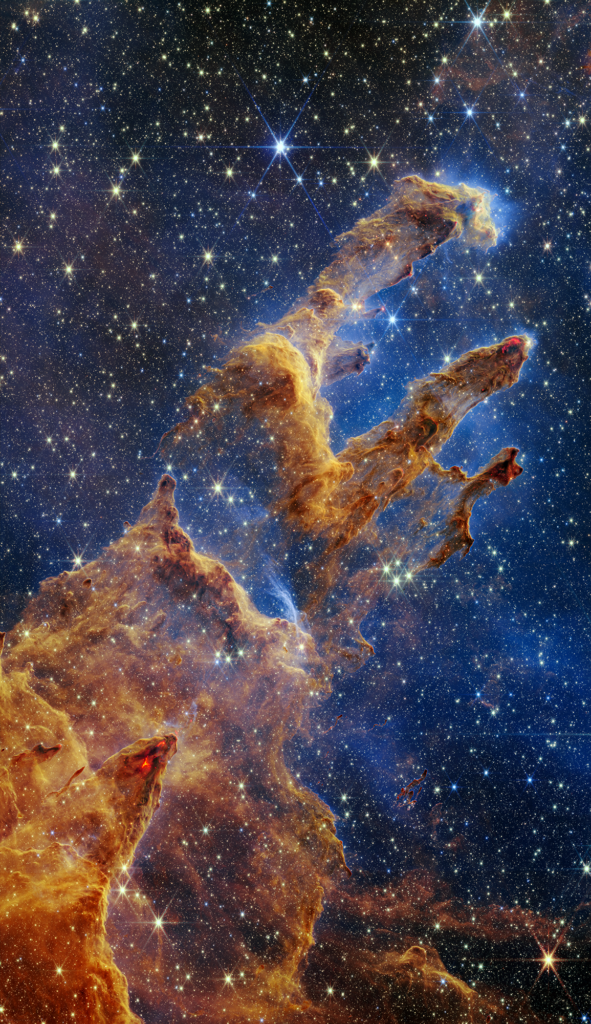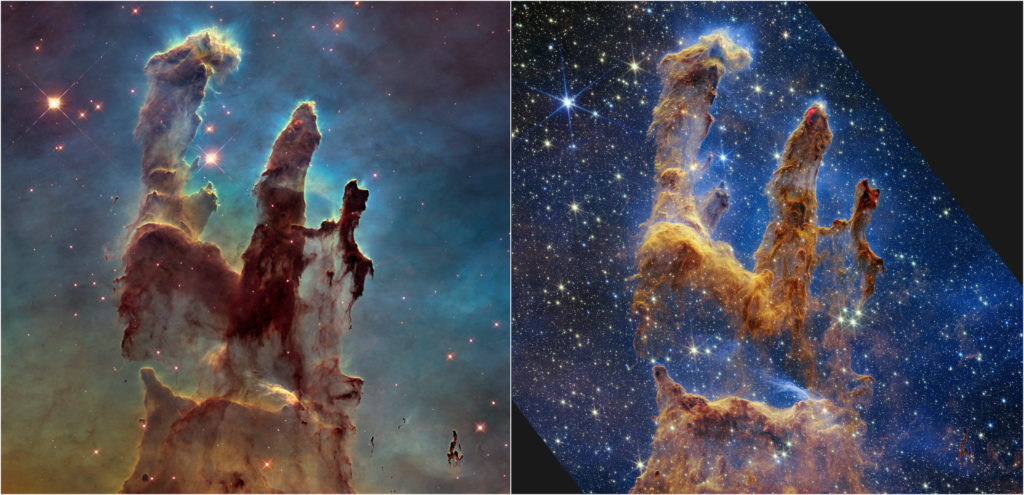A portrait of creative chaos, yet so zen – at least from 6,500 light-years away 😉
• NASA > APOD > Pillars of Creation (2022 October 20)

Explanation: A now famous picture from the Hubble Space Telescope featured these star forming columns of cold gas and dust light-years long inside M16, the Eagle Nebula, dubbed the Pillars of Creation.
This James Webb Space Telescope NIRCam image expands Hubble’s exploration of that region in greater detail and depth inside the iconic stellar nursery. Particularly stunning in Webb’s near infrared view is the telltale reddish emission from knots of material undergoing gravitational collapse to form stars within the natal clouds.
The Eagle Nebula is some 6,500 light-years distant.
The larger bright emission nebula is itself an easy target for binoculars or small telescopes.
M16 lies along the plane of our Milky Way galaxy in a nebula rich part of the sky, toward the split constellation Serpens Cauda (the tail of the snake).
• Cnet > “NASA’s Webb Telescope Captures Sharpest ‘Pillars of Creation’ Portrait Ever” by Eric Mack (Oct 20, 2022) – The chaos of space has never looked so spectacular in high definition.
A side-by-side comparison of the new image and Hubble’s take on the cosmic phenomenon reveals how Webb’s infrared instrument is able to peer through the curtains of dust and gas that shroud the scene.
• ESA > Multimedia > Images > “Hubble and Webb showcase the Pillars of Creation (side by side)” (10-19-2022)
The NASA/ESA Hubble Space Telescope made the Pillars of Creation famous with its first image in 1995, but revisited the scene in 2014 to reveal a sharper, wider view in visible light, shown at left.
A new, near-infrared-light view from the NASA/ESA/CSA James Webb Space Telescope, at right, helps us peer through more of the dust in this star-forming region. The thick, dusty brown pillars are no longer as opaque and many more red stars that are still forming come into view.
While the pillars of gas and dust seem darker and less penetrable in Hubble’s view, they appear more diaphanous in Webb’s.
Both views show us what is happening locally. Although Hubble highlights many more thick layers of dust and Webb shows more of the stars, neither shows us the deeper universe. Dust blocks the view in Hubble’s image, but the interstellar medium plays a major role in Webb’s. It acts like thick smoke or fog, preventing us from peering into the deeper universe, where countless galaxies exist.


Protostars in the Pillars: Detail [1] in the source (original) image (~150MB) reveals star formation in progress.
• Space.com > “Why the James Webb Space Telescope’s amazing ‘Pillars of Creation’ photo has astronomers buzzing” by Tereza Pultarova (Oct 24, 2022) – Seeing through interstellar dust, “It’s like taking the X-ray of a human.”
Notes
[1] “You can resolve things that are about the size of our solar system in the image,” Koekemoer [Anton Koekemoer, research astronomer at STScI] said. “If there were individual planets like Jupiter, you wouldn’t be able to resolve those.”
Color mapping of non-visible wavelengths:
[2] Professor Derek Ward-Thompson, veteran astronomer and head of the School of Natural Sciences at the University of Central Lancashire in the U.K.